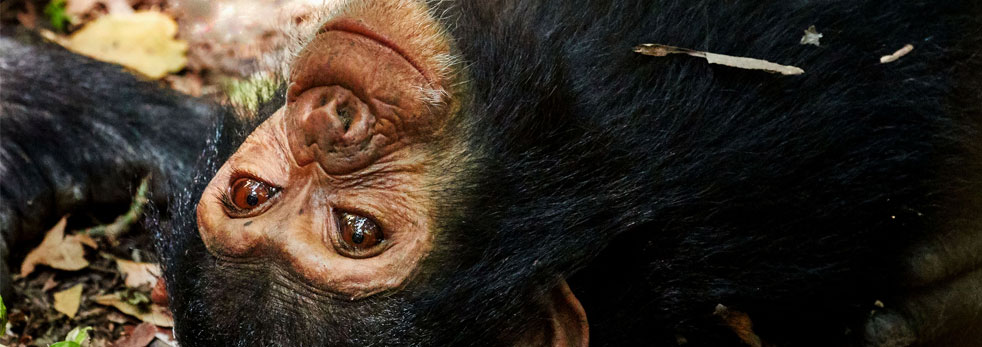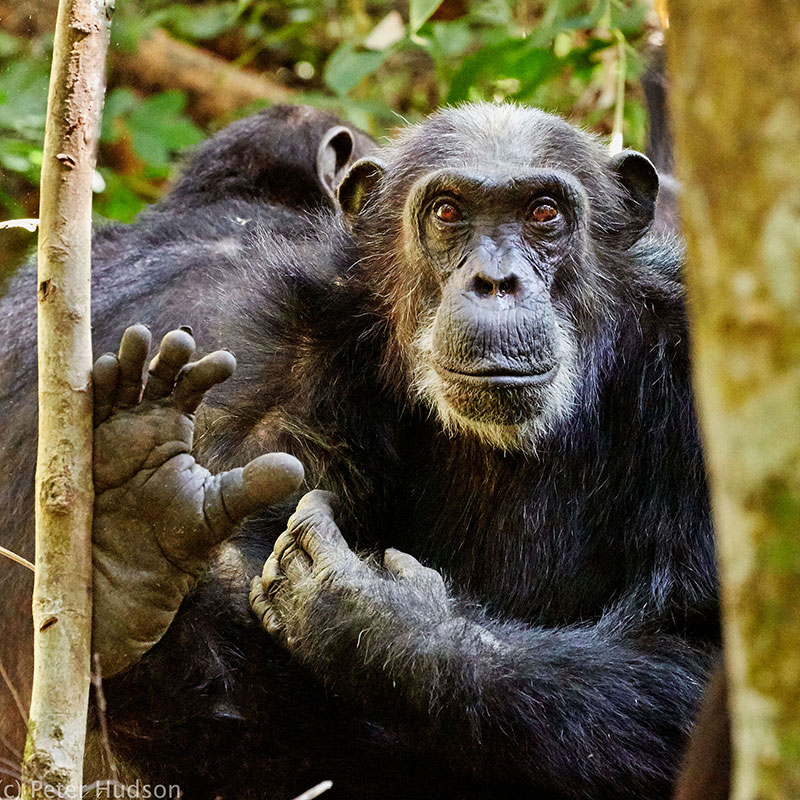
Peter Hudson is a professional biologist who studies the ecology of wildlife diseases including those infections that spillover from wildlife to humans. He is passionate about Biology and intrigued about how we can capture behaviour and interactions between animals using photography.
He is The Willaman Professor of Biology and The Director of Life sciences at Penn State and also a Professor at the Nelson Mandela Institute in Tanzania. He is a Fellow of The Royal Society.
Website: www.peterhudsonphotos.com

As a kid, my friends wanted to grow up and become the next Jackie Charlton or an underground guitarist like Eric Clapton .... but I wanted to be Jane Goodall. I loved the idea of studying the social behavior of chimps and living in the forest with them and discovering their social structure. As such, going to watch chimps has been right up there on my bucket list of the animals I most wanted to see and photograph.
Where to go?
My first encounter with chimps was in 1974 in the Ituri forest of the Congo - an adult chimp dropped out of a tree, really quite close to me, and then all I saw was a chimp bottom disappearing into the forest. So if you want to see chimpanzees, rule number 1, is to visit a habituated group so you can at least get close enough to photograph and watch them behave naturally. Rule number 2, is not to look the chimps in the eye since they nd this threatening and they will just walk away - and you just end up with yet more photos of chimp bottoms. Rule 3 is you must wear a face-mask while you are with the chimps so you don’t inadvertently pass the chimps an infectious disease like influenza.
While Gombe, the study site of Jane Goodall is the obvious place to visit, it is a small reserve and really threatened by logging. After reading some of the scientific papers and the trip reports online I felt Mahale, south of Gombe but still on the shores of Lake Tanganyika, was a much more interesting place to visit. Mahale is a beautiful, beautiful forest - with gentle rolling terrain around the edge of an old volcano and the easily accessible part of he home range of the M troop of chimps. The camp is fabulous and chimps, baboons, warthogs all just walk through the camp and the troop of chimps is rarely more than a 40 minute walk. Sixtus my guide was superb, knowledgeable, interested and both sensitive and sensible about the chimps - they come rst and his field craft was gentle and wise. I stayed at the wonderful Kungwe Resort, on the beach at Lake Tanganyika, not cheap but the food, service and management were some of the best I have ever experienced in Africa and well worth every penny. I plan to go back and I would recommend the place with 5 stars every time. You spend most mornings watching chimps, the food is excellent and you can relax or photograph the other primates and animals that live in the forest.
The characters of M troop
The Mahale chimps have been studied by Japanese researchers since the early 1960s and the M group is well habituated to the presence of humans. You are allowed to watch them for 2 hours a day - but not interfere with their behaviour - and this is 2 hours of biological and photo-opportunity bliss. Since they have studied this troop for so long they know so much about them – each individual is named and they know their pedigree. The troop is run by a group of 5 senior males. Let me introduce you to some of the main characters from the M group.
Primus - the alpha male: The alpha male at the current time is 23 year old Primus, born and raised in the troop by his now deceased mother, Pinky. He never pant- grunts but receives pant-grunts from all the others, so when you hear the commotion of pant-grunts just follow the noise and then you will find the alpha male. The previous alpha was called Pimu and he was a nasty piece of work, bullying and beating up the other chimps.
In October 2011, Primus was grooming the alpha male Pimu when he suddenly turned around and bit Primus. Primus called for assistance and the other males came to his rescue and one by one they sided with Primus until they had bitten and beaten Pimu, nally throwing a big stone on him and leaving him to die.
Kalunde - “The Kingmaker”: Kalunde is the gentle old male of the troop and at 53 you may think he is over the hill but he is still a firm favourite with the females and he has been the alpha male several times in the past. He has real expertise in influencing the politics and has the knack for forming alliances and choosing the winning side thereby getting to choose who the next Alpha male will be.
He is Kalunde... the Kingmaker!
Darwin - The cool one : A 26 year old male chimp, who is in the group of the 5 leading males and coincidentally my favourite male. He comes across as an easy going, relaxed male, happy to let you watch him as he quietly sits there, eats fruit and picks his nose. He is a peace loving chimp and though he sometimes chooses the wrong side in the battles, he’s still a good guy. I am sure I am biased towards him since the original Charles Darwin is without question a huge hero of mine.
Orion - The naughty one: You can’t trust Orion. You really must be careful not to catch his eye because he might just charge or pick something up and throw it at you. Even when you look sideways at him, you know he is thinking about doing something naughty. We were quietly watching a group one morning and he decided he wanted to walk straight past where we were sitting so he did a quick mock charge - slapped the tree next to us and moved on.
Gwekulo - The amazing one: Adolescent females move between troops while males tend to stay in their natal troop. Gwekulo is an old female in her 50s who immigrated into the neighboring K troop in 1972 and then moved into our M troop when the K troop disbanded. Before this, as a youngster, she was captured by some local people and taken down Lake Tanganyika in a cage from which she escaped and made it all the way back to Mahale. She has never had a baby as far as is known and she is thought to be sterile. But she has been a wonderful auntie, caring for the babies of sick mothers and taking over the care of another baby when the mother died.

Chimp Behaviour
While working out the character of each chimp is fascinating, I really enjoyed the diversity of the ritualized and non-ritualized behaviours the chimps exhibited. You start to see them as a social group and watch them interact. Truly fascinating. Here are some of the behavior patterns you can expect to see.
Chimp Slapping Display: Making noise and commotion is part of the chimp’s process of intimidation - this is really aimed at the males from neighboring troops, although I can’t help wondering if the impressive displays would also tempt adolescent females to come and join the troop. The Japanese researchers who study the troop, used to live in these round aluminum buildings at Kansyana, based near the southern end of the M troops territory. Slapping these buildings to make big noise has now become part of the culture of the M troop and is well described in the book by Toshisada Nashida: Chimpanzees of the Lakeshore.
Charging Display: A male chimp weighs in at about 100 pounds and is astonishingly strong, so when one charges there is serious power involved. During the charging display - all described in beautiful detail by Jane Goodall - he thumps his feet, may carry and throw tools and will often pant-hoot at the same time. When he is pant-hooting the threat isn’t so much aimed at one individual but as part of his intimidation aimed at neighbors. The silent charges are focused on an individual and we experienced a couple of those - that were aimed at us. In a pant- hoot charge, he ran straight past where we were sitting.
Social Grooming: Grooming is the currency of communication and immensely important to chimps. While the origin of grooming was to simply remove the ectoparasites of friends and family it is a very important part of social life. Chimps groom to form liaisons, to bond with family, to build a sexual relationship, to reconcile rivals after aggressive encounters and for forming coalitions against rivals.
Hand Clasp Grooming: This is an intriguing behavior because of its geographical variation. The behaviour is not uncommon in Mahale and some other locations but has never been recorded just up the coast amongst the Gombe chimps. This behavior was first recorded in 1978 at Mahale by one of my colleagues from Scotland, the charming Caroline Tutin. The chimp holds it’s hand up in the air and the other chimp usually holds their hand so they can groom the armpits.
Anting: Originally researchers supposed chimps were herbivores and survived on leaves and shoots but they do eat termites, ants. Now we know meat eating and the predation of other mammals and even cannibalism are not uncommon. Ants are now considered part of the staple diet of chimps although they have to make sure they don’t get bitten.
Fishing for Termites: One of Jane Goodall’s astonishing findings was that chimps will make and use tools to capture termites and ants. Prior to this finding it was generally thought that only humans made tools, but she showed how they cut twigs and then poke them in termite nests to fish out the termites that they lick off the twig. Young chimps learn the technique by imitating their mothers.
Photographing chimps: Be prepared to walk – it is a dry easy forest to walk through but steep hills are also present and you may have to walk a couple of hours before you catchup with the troop. Every morning the camp sends out a guide who locates the troop and after a sumptuous breakfast you walk, or catch a boat to where the chimps are feeding or just hanging out. Since you want to be agile through the forest, you really don’t want to carry too much over and above your water bottle. I think a 70-200mm lens on a full frame body with the option of adding a 1.4 multiplier is ideal. Your guide will keep you straight on chimp etiquette and ensure you don’t disturb the animals. You will enjoy taking photographs of chimp behaviour and the really cute babies. They are precocious and will watch you and want to see what you are up to while the adults avoid looking at you.
Image Gallery
Copyright © 2026. All rights reserved. PAWS TRAILS EXPLORERS